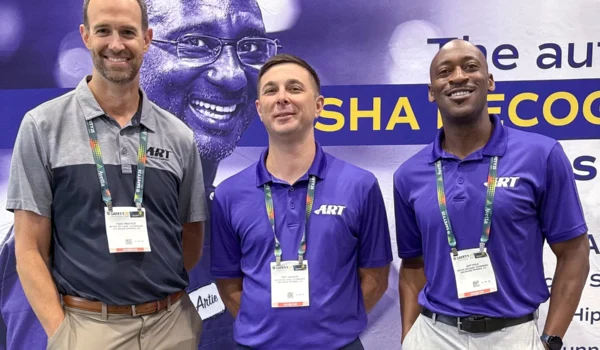Are you a health care provider looking into certification options for CEUs or just wanting to learn something new to give your patients better treatment?
Keep reading to learn how ART treatment is different from other soft-tissue and nerve dysfunction treatment methods.
What is ART treatment?
Active Release Techniques® (ART®) treatment is a non-invasive system that treats soft-tissue and nerve dysfunction at the source. This hands-on treatment uses a combination of provider touch, depth, and tension with patient movement to pinpoint and treat the origin of the affected area.
ART seminars
There are 12 different ART seminars available to health care professionals, or students actively pursuing a health care degree.
ART seminars offer a hybrid learning environment that includes online modules and hands-on training components.
While the online portion is self-guided, the hands-on training is led by a group of the brightest minds in soft-tissue care, ART Instructors. ART Instructors go through rigorous training and testing to become eligible to teach ART treatment to seminar attendees.
Learn more about what to expect during an ART seminar here.
Advanced Soft Tissue Release
ART treatment and Advanced Soft Tissue Release (ASTR) are manual therapy approaches used to address soft tissue and musculoskeletal conditions.
ASTR is a therapeutic approach combining manual therapy techniques like myofascial release, trigger point therapy, joint mobilization, and stretching to target soft tissue dysfunction.
ASTR can provide long-term pain relief to patients.
When learning ASTR, providers utilize a biopsychosocial model that considers a patient’s biological, social, and psychological factors when evaluating their condition.
This approach combines tools to assist a provider in treatment sessions available for purchase when registering for an online and self-paced course with over 14 hours of educational materials.
The main points covered in an ASTR course include:
- Proper use of the ASTR tools with myofascial release, visceral fascia release, and scar tissue release
- Diagnosis algorithm and treatment protocols
- Integrating treatment with diets, supplements, exercise, and nutrition
Graston Technique
ART treatment and Graston Technique® are both non-invasive soft-tissue therapy methods dedicated to healing soft-tissue and musculoskeletal conditions.
The Graston Technique (GT) therapy is a form of instrument-assisted soft-tissue mobilization (IASTM) since it utilizes a specifically designed stainless steel instrument to detect and treat soft-tissue dysfunction.
While a health care provider applies the instrument to the patient’s skin in a scraping or stroking motion, the goal is to promote healing, improve blood flow, and reduce pain by targeting scar tissue or fascial restrictions.
Graston Technique offers four sequential courses to health care professionals wanting to become Graston Technique Providers or Graston Technique Specialists.
Learning GT therapy offers four training options for their beginner’s course: in-person, hybrid, live online, and self-paced.
Most of the training includes hands-on, or lab-setting practice to understand how to properly use the instruments, introduce GT therapy into a clinic’s billing process, and evaluate post-GT therapy treatment responses.
Myofascial Trigger Point Release
ART treatment and Myofascial Trigger Point Release are highly evidence-based methods that break up scar tissue and improve muscle function.
While each treats a variety of soft tissue and nerve conditions, ART treatment specializes in finding the source of the problem and treating soft tissue conditions due to injury while Myofascial Trigger Point Release is broadly a pain management resource for muscle tightness.
The Myofascial Trigger Point Release technique is applied through deep pressure, kneading, and stretching focused on myofascial tissues.
Certified Myofascial Trigger Point Therapists learn how to apply pressure and manual manipulation to specific points referred to as trigger points. The goal is to reduce patients’ muscle tension, improve blood flow, and decrease contracted muscle fibers.
There are various courses health care professionals can take to become certified. Many are hybrid with a combination of self-paced virtual components and hands-on training.
Providers must recertify every five years.
How is an ART seminar different?
ART treatment is a hands-on approach that focuses on locating and treating scar tissue that develops in the muscles, tendons, or ligaments by utilizing the ART Diagnostic Algorithm.
ART Certified Providers™ use specific ART protocols that involve precise hand movements and patient movements to pinpoint the source of the problem.
Providers are required to recertify every year due to the curriculum updates that come with constant emerging new soft tissue and nerve research.
This means ART Certified Providers that are up to date with their certifications, are giving the best and most effective soft-tissue care.
What happens after successfully completing an ART seminar?
- You become a more efficient provider.
- You are treating your patients within a shorter timeframe.
- New career opportunities that are ART specific become available.
- Set yourself apart and have a leg up on competitors.
Learning ART treatment will provide your patients with long-term solutions to their pain rather than temporary fixes.
Ready to become an ART Certified Provider?
Do you feel that becoming an ART Certified Provider makes sense for you?
Find a seminar that interests you and register today by clicking here.




